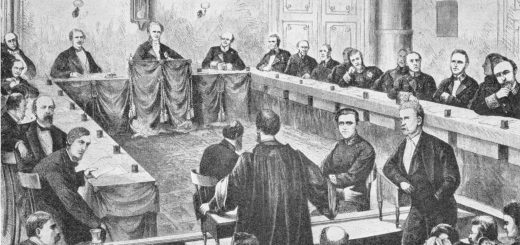Motorcycle Accident Breaks Expectations for Psychiatric Damages: Frazer v Dr. Haukioja
On April 7, 2010 the Ontario Court of Appeal (“OCA”) revisited the “thin skull” principle in Frazer v Dr. Haukioja, 2010 ONCA 249 [Haukioja]. The court decided issues related to medical professionalism after Grant Frazer took a vicious spill on his motorcycle and broke his ankle. The following action against his physician, Dr. Haukioja, resulted in damages awarded for psychiatric injury. He and his partner then sued the physician, convinced of being lied to when the pain continued despite advice to stop using crutches and work through the pain to recover.
A Pain in the Ankle
Almost a decade ago, Mr. Frazer landed in the emergency room at Northumberland Hospital after a crushing motorcycle accident. He was diagnosed and treated by Dr. Haukioja, described in the judgement as a “charismatic, humourous and confident man.” Dr. Haukioja set Mr. Frazer’s left ankle fracture with a cast, and diagnosed the right ankle as having a “soft tissue injury” not requiring a cast. Mr. Frazer was discharged about a week later with a follow-up appointment with Dr. Haukioja scheduled on January 10th, 2002.
Two weeks later, however, a radiologist, Dr. Marrocco “immediately noticed a talus fracture in Mr. Frazer’s right ankle.” This physician then discussed his findings with Dr. Haukioja who did not inform Mr. Frazer about the fracture until the January 10th, 2002 appointment because the fracture was reasonably characterized as “tiny, barely visible and not requiring treatment.” When Mr. Frazer continued to experience attacks of severe pain in his right ankle at his employment as a grade school teacher. Over the next week, he sought a third medical opinion from Dr. Woodward at a walk-in clinic who diagnosed the right-ankle injury as a “major fracture…that might require surgical intervention.” Following this news, Mr. Frazer was described as becoming “hyper alert,” “hyper aware,” and suffering from an anxiety disorder with “intermittent” depressive and emotional states.
On August 27th, 2008, Mr. Frazer brought an action to claim damages against his former doctor, Dr. Haukioja. Mr. Frazer’s partner, Jennifer Smith as co-plaintiff sued for damages for her loss of care, guidance and companionship arising from Mr. Frazer’s injuries. The trial judge found that Dr. Haukioja not negligent during his initial treatment of Mr. Frazer, but breached the standard of care in not advising the patient of his talus fracture when the radiology report became available. In addition to awarding damages for failure to advise Mr. Fraser about the right-ankle fracture, the trial judge awarded $150,000 in general damages related to the psychiatric injury flowing Dr. Haukioja’s “failure to properly treat his patient.”
Dr. Haukioja appealed the decision to the Court of Appeal.
What’s the Big Deal?
The main issue at the OCA centred upon the cause of psychiatric damages. According to expert testimony, Mr. Frazer suffered from anxiety disorder with features of panic disorder that did not reach the level of having a personality disorder. Mindful of the fact that the patient’s personality “changed dramatically” following the motorcycle accident, the trial judge concluded liability based on the “but for” test and if incorrect, causation on the material contribution test flowing from the chain of events that occurred at the hospital and subsequent treatment following discharge from medical care. Nevertheless, contrary to Mr. Frazer claims, there was no evidence to support the finding that Dr. Haukioja held any “ill will” or “deliberately exposed” his patient to risk.
Dr. Haukioja’s appeal implied, but did not explicitly mention, the “thin skull doctrine” that holds a defendant liable for tortious conduct that causes an unusually vulnerable victim a high level of damage. In this case, the defendant doctor claimed that psychiatric damages were too remote and beyond a reasonable level of foreseeability for a person of ordinary fortitude to react as strongly as Mr. Frazer did to a broken ankle. Moreover, the appellant argued against the “but for” test. He claimed that causation of Mr. Frazer’s psychiatric response was not established by the physician’s conduct. As such, damages and costs should be reduced and considered unreasonable.
In hearing the arguments, the Court of Appeal dismissed Dr. Haukioja’s appeal. The Court of Appeal judge held that:
1) The trial judge erred in applying the “material contribution” test but correctly applied the “but for” test that the psychiatric damage was caused by the doctor’s non-disclosure;
2) The patient’s mental health was a reasonably foreseeable consequence of non-disclosure flowing from a patient-doctor relationship;
3) Damages awarded by the trial judge were reasonable and correctly considered in light of Mr. Frazer’s injuries preventing him from returning to work consistent with a future loss of income claim.
Protecting Sensitive Plaintiffs
With respect to the psychiatric damages, the OCA cited Mustapha v Culligan of Canada Ltd., [2008] 2 SCR 114 [Mustapha]. In Mustapha, the appellant spiraled into a debilitating anxiety disorder, depression and agoraphobia after discovering a fly in his bottle of water. In true Donoghue v Stevenson, [1932] All ER Rep 1 (HL) style, he brought a claim against the water bottle company. His claim was dismissed after the Court applied the Anns test (Anns v Merton London Borough Council, [1978] AC 728 (HL) for negligence:
1) A relationship of fiduciary duty must be established;
2) A standard of care was breached; and
3) A breach caused reasonably foreseeable damages.
Although in Haukioja, the OCA eschewed to run through the entire Ann’s Test cited in Mustapha, the court nevertheless established a duty of care particularly in the context of doctor-patient relationships. The court also found that Dr. Haukioja fell below the requisite standard of care by failing to “take active steps to communicate the information [about the talus fracture] to Mr. Frazer,” and much like the SCC in Mustapha, psychiatric damage as occurred in this case is a recognized and accepted injury compensable in actions for negligence. General emotional upset for particularly sensitive individuals, however, does not require the same level of compensability, unless it is a recognized psychiatric illness. In this case, Mr. Frazer was distinguished from Mr. Mustapha, whose reactions to a fly in a water bottle were “unusual, strange and highly individualized.”
The OCA found that Mr. Frazer had recognized psychiatric damage to non-disclosure of an ankle fracture that was compensable. The OCA judge in considering expert psychiatric opinion and the trial judge’s findings was particularly unconvinced about the remoteness of damages because, in the mind of the patient, his severe talus fracture was “medically mistreated,” “deliberately harmed” and thus reasonably caused psychiatric damage to Mr. Frazer who was a “person of ordinary mental fortitude…left with the understanding that the fracture was tiny, barely visible and minor.” Therefore, the patient reasonably developed psychiatric damages when informed on a much later date “the true nature of his injury” that he claimed was the fault of his doctor’s non-disclosure.
Thin-Skull or Thin-Skin?
As the OCA noted, this is a torts case that revisits remoteness for psychological injuries in the context of doctor-patient relationships. Unlike previous cases looking at those of a contractual, commercial nature, and in light of accident-caused injuries, the court held the doctor to a higher standard of care for disclosure within a doctor-patient relationship causing emotional and psychiatric effect to the patient.
In my opinion, this case was unfair by attributing negligence to the medical professional. This particular set of facts sets a high standard for a doctor’s judgement about the emotional and psychological reactions of reasonable medical disclosure to patients. Understandably, a motorcycle accident is a traumatic experience and ensuring trust in medical professions is a paramount policy objective. However, judging from the facts of the case, the doctor acted reasonably in an emergency room context by making an informed decision about the patient’s injuries. Disclosure may perhaps be less important than proper medical treatment of a correctly diagnosed injury. The initial minor nature of the broken ankle was a diagnosis made according to an acceptable standard of care that showed no signs of ordinary, egregious or gross negligence. Dr. Haukioja may have taken into account the possibility of escalating into a more severe fracture when diagnosing the severity of the injury.
This case is another example of how thin-skull claimants can dramatize factually innocuous injuries that increase in severity, but are extreme psychiatric reactions to the timing of disclosure or other alleged injuries. It appeared to be a battle of mixed medical opinions that unfortunately caused greater distress to a patient who may have reacted just as negatively to an earlier disclosure.








Join the conversation